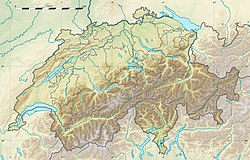Lucens Nuclear Power Plant
| Lucens reactor | |
|---|---|

Control room of the Lucens reactor in April 1968
|
|
| Official name | Versuchsatomkraftwerk Lucens |
| Country | Switzerland |
| Location | Lucens, Vaud |
| Coordinates | 46°41′34.16″N 6°49′36.81″E / 46.6928222°N 6.8268917°ECoordinates: 46°41′34.16″N 6°49′36.81″E / 46.6928222°N 6.8268917°E |
| Status | decommissioned |
| Construction began | 1 April 1962 |
| Commission date | 10 May 1968 |
| Decommission date | 3 March 1969 |
| Owner(s) | Nationale Gesellschaft zur Förderung der industriellen Atomtechnik |
| Operator(s) | Energie Ouest Suisse |
| Nuclear power station | |
| Reactor type | PHWR |
| Reactor supplier | Thermatom |
| Fuel type | Low enriched uranium |
| Cooling source | Carbon dioxide |
| Power generation | |
| Units decommissioned | 1 x 6 MW |
| Nameplate capacity | 6 MW |
|
Website www |
|
| Suffered a nuclear accident on 21 January 1969, leading to a partial core meltdown and massive radioactive contamination | |
The Lucens reactor was a 6 MW experimental nuclear power reactor built next to Lucens, Vaud, Switzerland. After its connection to the electrical grid on 29 January 1968, the reactor only operated for a few months before it suffered a loss-of-coolant accident on 21 January 1969, leading to the meltdown of one of the five fuel elements and radioactive contamination of the cavern.
In 1962 the construction of a Swiss-designed pilot nuclear power plant began. The heavy-water moderated, carbon dioxide gas-cooled reactor was built in an underground cavern. It produced 28 MW of heat, which was used to generate 6 MW of electricity, and it became critical 29 December 1966. It was fueled by 0.96% enriched uranium alloyed with chromium cased in magnesium alloy (magnesium with 0.6% zirconium) inserted into a graphite matrix. Carbon dioxide gas was pumped into the top of the channels at 6.28 MPa and 223 °C and exited the channels at a pressure of 5.79 MPa and at a temperature of 378 °C.
It was intended to operate until the end of 1969, but during a startup on 21 January 1969, it suffered a loss-of-coolant accident, leading to a partial core meltdown and the radioactive contamination of the cavern, which was then sealed. The accident was rated 4 on the International Nuclear Event Scale introduced in 1990 by the International Atomic Energy Agency.
...
Wikipedia

